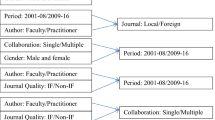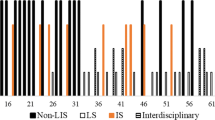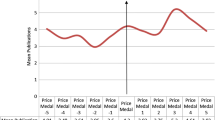Abstract
This study investigated the characteristics of articles by high research performance authors in the field of library and information science (LIS) by comparing the articles by two control groups of highly cited authors and prolific authors. The comparison was conducted on the basis of the articles indexed by Web of Science between 2009 and 2013 and their citation counts as of August 2019. Research results suggested that both high research performance authors and highly cited authors produced a significantly higher percentage of coauthored articles than prolific authors did. Moreover, they published a higher percentage of international collaborative articles in Q1 journals. Most high research performance researchers conducted scientometric research, whereas most highly cited researchers worked in the domain of management and computer science expertise and published their research results in journals relevant to their field. Additionally, prolific researchers mostly preferred to publish articles in LIS journals, whereas highly cited researchers tended to publish more articles in non-LIS journals. Prolific authors did not adopt coauthorship to improve productivity but targeted non-Q1 journals with higher rates of acceptance. Academic age was not a determining factor for distinguishing research performance among all three groups of researchers. Each group of researchers comprised both junior and senior researchers.


Similar content being viewed by others
References
Aarssen, L. W., Lortie, C. J., Budden, A. E., Koricheva, J., Leimu, R., & Tregenza, T. (2009). Does publication in top-tier journals affect reviewer behavior? PLoS ONE, 4(7), e6283. https://doi.org/10.1371/journal.pone.0006283.
Abramo, G., Cicero, T., & D’Angelo, C. A. (2014). Are the authors of highly cited articles also the most productive ones? Journal of Informetrics, 8(1), 89–97.
Abrizah, A., Noorhidawati, A., & Zainab, A. N. (2015). LIS journals categorization in the journal citation report: A stated preference study. Scientometrics, 102(2), 1083–1099.
Adkins, D., & Budd, J. (2006). Scholarly productivity of US LIS faculty. Library and Information Science Research, 28(3), 374–389.
Akbaritabar, A., Casnici, N., & Squazzoni, F. (2018). The conundrum of research productivity: A study on sociologists in Italy. Scientometrics, 114(3), 859–882.
Albarran, P., & Ruiz-Castillo, J. (2011). References made and citations received by scientific articles. Journal of the American Society for Information Science and Technology, 62(1), 40–49.
Asubiaro, T. (2019). How collaboration type, publication place, funding and author’s role affect citations received by publications from Africa: A bibliometric study of LIS research from 1996 to 2015. Scientometrics, 120(3), 1261–1287.
Avanesova, A. A., & Shamliyan, T. A. (2018). Comparative trends in research performance of the Russian universities. Scientometrics, 116(3), 2019–2052.
Bauer, J., Leydesdorff, L., & Bornmann, L. (2016). Highly cited papers in library and information science (LIS): Authors, institutions, and network structures. Journal of the Association for Information Science and Technology, 67(12), 3095–3100.
Budd, J. M. (2000). Scholarly productivity of U.S. LIS faculty: An update. The Library Quarterly, 70(2), 230–245.
Budd, J. M., & Seavey, C. A. (1996). Productivity of US library and information science faculty: The Hayes study revisited. The Library Quarterly, 66(1), 1–20.
Chang, Y. W. (2018a). Examining interdisciplinarity of library and information science (LIS) based on LIS articles contributed by non-LIS authors. Scientometrics, 116(3), 1589–1613.
Chang, Y. W. (2018b). Exploring the interdisciplinary characteristics of library and information science (LIS) from the perspective of interdisciplinary LIS authors. Library and Information Science Research, 40(2), 125–134.
Chang, Y. W. (2019). Are articles in library and information science (LIS) journals primarily contributed to by LIS authors? Scientometrics, 121(1), 81–104.
Chang, Y. W., Chen, D. Z., & Huang, M. H. (2020). Discovering types of research performance of scientists with significant contributions. Scientometrics, 124(2), 1529–1552.
Davarpanah, M. R., & Aslekia, S. (2008). A scientometric analysis of international LIS journals: Productivity and characteristics. Scientometrics, 77(1), 21–39.
Dhillon, S. K., Ibrahim, R., & Selamat, A. (2015). Factors associated with scholarly publication productivity among academic staff: Case of a Malaysian public university. Technology in Society, 42, 160–166.
Didegah, F., & Thelwall, M. (2013). Determinants of research citation impact in nanoscience and nanotechnology. Journal of the American Society for Information Science and Technology, 64(5), 1055–1064.
Dorta-Gonzalez, P., & Santana-Jimenez, Y. (2019). Characterizing the highly cited articles: A large-scale bibliometric analysis of the top 1% most cited research. Malaysian Journal of Library and Information Science, 24(2), 23–39.
D’Souza, B., Kulkarni, S., & Cerejo, C. (2018). Authors’ perspectives on academic publishing: Initial observations from a largescale global survey. Science Editing, 5(1), 39–43.
Franceschet, M., & Costantini, A. (2010). The effect of scholar collaboration on impact and quality of academic papers. Journal of Informetrics, 4(4), 540–553.
Garg, K. C., Kumar, S., & Lal, K. (2006). Scientometric profile of Indian agricultural research as seen through Science Citation Index Expanded. Scientometrics, 68(1), 151–166.
Garg, K. C., & Padhi, P. (2000). Scientometrics of prolific and non-prolific authors in laser science and technology. Scientometrics, 49(3), 359–371.
Gazni, A., & Didegah, F. (2011). Investigating different types of research collaboration and citation impact: A case study of Harvard University’s publications. Scientometrics, 87(2), 251–265.
Gorjizadeh, D., & Eftekhar, A. (2016). A scientometric analysis of scholarly publication in the fields of management, operations, economics, and business from Iran. Journal of Scholarly Publishing, 47(4), 347–361.
Haensly, P. J., Hodges, P. E., & Davenport, S. A. (2009). Acceptance rates and journal quality: An analysis of journals in economics and finance. Journal of Business and Finance Librarianship, 14(1), 2–31.
Halim, Z., & Khan, S. (2019). A data science-based framework to categorize academic journals. Scientometrics, 119(1), 393–423.
Han, P., Shi, J., Li, X. Y., Wang, D. B., Shen, S., & Su, X. N. (2014). International collaboration in LIS: Global trends and networks at the country and institution level. Scientometrics, 98(1), 53–72.
Haslam, N., Ban, L., Kaufmann, L., Loughnan, S., Peters, K., Whelan, J., & Wilson, S. (2008). What makes an article influential? Predicting impact in social and personality psychology. Scientometrics, 76(1), 169–185.
Hayes, R. M. (1983). Citation statistics as a measure of faculty research productivity. Journal of Education for Librarianship, 23(3), 151–172.
Henriksen, D. (2016). The rise in co-authorship in the social sciences (1980–2013). Scientometrics, 107(2), 455–476.
Huang, M. H., & Chang, Y. W. (2008). Characteristics of research output in social sciences and humanities: From a research evaluation perspective. Journal of the American Society for Information Science and Technology, 59(11), 1819–1828.
Huang, M. H., & Chang, Y. W. (2012). A comparative study of interdisciplinary changes between information science and library science. Scientometrics, 91(3), 789–803.
Ibáñez, A., Bielza, C., & Larrañaga, P. (2013). Relationship among research collaboration, number of documents and number of citations: A case study in Spanish computer science production in 2000–2009. Scientometrics, 95(2), 689–716.
Ivanović, D., & Ho, Y. S. (2016). Highly cited articles in the information science and library science category in social science citation index: A bibliometric analysis. Journal of Librarianship and Information Science, 48(1), 36–46.
Jiang, H., Nong, B. J., Yang, L. J., Zong, S. H., Zhan, X. L., Wei, Q. J., & Xiao, Z. M. (2016). Assessing the evolution of scientific publications in orthopedics journals from mainland China, Hong Kong, and Taiwan: A 12-year survey of the literature. Journal of Orthopaedic Surgery and Research. https://doi.org/10.1186/s13018-016-0404-z.
Kademani, B. S., Sagar, A., & Bhanumurthy, K. (2011). Research and impact of materials science publications in India: 1999–2008. Malaysian Journal of Library and Information Science, 16(2), 63–80.
Katz, J. S. (1994). Geographical proximity and scientific collaboration. Scientometrics, 31(1), 31–43.
Kyvik, S. (1990). Age and scientific productivity. Differences between fields of learning. Higher Education, 19, 37–55.
Lee, D. H. (2019). Predicting the research performance of early career scientists. Scientometrics, 121(3), 1481–1504.
Levitt, J. M. (2015). What is the optimal number of researchers for social science research? Scientometrics, 102(1), 213–225.
McNally, G. P. (2010). Scholarly productivity, impact, and quality among academic psychologists at group of eight universities. Australian Journal of Psychology, 62(4), 204–215.
Mukherjee, B. (2009). Journal of the American Society for Information Science and Technology (2000–2007): A bibliometric study. IFLA Journal, 35(4), 341–358.
Peng, T. Q., & Zhu, J. J. H. (2012). Where you publish matters most: A multilevel analysis of factors affecting citations of internet studies. Journal of the American Society for Information Science and Technology, 63(9), 1789–1803.
Perlin, M. S., Santos, A. A. P., Imasato, T., Borenstein, D., & Da Silva, S. (2017). The Brazilian scientific output published in journals: A study based on a large CV database. Journal of Informetrics, 11(1), 18–31.
Rowlands, I. (2005). Emerald authorship data, Lotka’s law and research productivity. Aslib Proceedings, 57(1), 5–10.
Royle, P., Kandala, N. B., Barnard, K., & Waugh, N. (2013). Bibliometrics of systematic reviews: Analysis of citation rates and journal impact factors. Systematic Reviews, 2, 74. https://doi.org/10.1186/2046-4053-2-74.
Rutledge, R. W., Karim, K. E., & Reinstein, A. (2011). What factors influence the number of coauthors in the published research of the most productive authors in accounting literature? A long-term study. Advances in Accounting Behavioral Research, 14, 191–225.
Sagar, A., Kademani, B. S., Garg, R. G., & Kumar, V. (2010). Scientometric mapping of tsunami publications: A citation based study. Malaysian Journal of Library and Information Science, 15(1), 23–40.
Sandstrom, U., & van den Besselaar, P. (2016). Quantity and/or quality? The importance of publishing many papers. PLoS ONE, 11(11), e0166149.
Sinatra, R., Wang, D., Deville, P., Song, C., & Barabási, A. L. (2016). Quantifying the evolution of individual scientific impact. Science, 354, 6312–5239.
Soheili, F., Khasseh, A. A., & Mousavi-Chelak, A. (2017). The most influential researchers in information behaviour: An integrative view on influence indicators. Aslib Journal of Information Management, 69(2), 215–229.
Sooryamoorthy, R. (2017). Do types of collaboration change citation? A scientometric analysis of social science publications in South Africa. Scientometrics, 111(1), 379–400.
Stephan, P. E., & Levin, S. G. (1993). Age and the Nobel Prize revisited. Scientometrics, 28(3), 387–399.
Tahamtan, I., Safipour Afshar, A., & Ahamdzadeh, K. (2016). Factors affecting number of citations: A comprehensive review of the literature. Scientometrics, 107(3), 1195–1225.
Urbano, C., & Ardanuy, J. (2020). Cross-disciplinary collaboration versus coexistence in LIS serials: Analysis of authorship affiliations in four European countries. Scientometrics, 124(1), 575–602.
van Osselaer, S. M. J., & Lim, S. (2019). Research productivity of faculty at 30 leading marketing departments. Marketing Letters, 30(2), 121–137. https://doi.org/10.1007/s11002-019-09489-5.
Wager, E., Singhvi, S., & Kleinert, S. (2015). Too much of a good thing? An observational study of prolific authors. PeerJ, 3, e1154. https://doi.org/10.7717/peerj.1154.
Walters, G. D. (2006). Predicting subsequent citations to articles published in twelve crime-psychology journals: Author impact versus journal impact. Scientometrics, 69(3), 499–510.
Walters, W. H., & Wilder, E. I. (2015). Worldwide contributors to the literature of library and information science: Top authors, 2007–2012. Scientometrics, 103(1), 301–327.
White, C. S., James, K., Burke, L. A., & Allen, R. S. (2012). What makes a “research star”? Factors influencing the research productivity of business faculty. International Journal of Productivity and Performance Management, 61(6), 584–602.
Yazit, N., & Zainab, A. N. (2007). Publication productivity of Malaysian authors and institutions in LIS. Malaysian Journal of Library and Information Science, 12(2), 35–55.
Yu, T., Yu, G., Li, P. Y., & Wang, L. (2014). Citation impact prediction for scientific papers using stepwise regression analysis. Scientometrics, 101(2), 1233–1252.
Zanotto, S. R., Haeffner, C., & Guimaraes, J. A. (2016). Unbalanced international collaboration affects adversely the usefulness of countries’ scientific output as well as their technological and social impact. Scientometrics, 109(3), 1789–1814.
Zhou, J. J., Koltz, M. T., Agarwal, N., Tempel, Z. J., Kanter, A. S., Okonkwo, D. O., & Hamilton, D. K. (2017). 100 most influential publications in scoliosis surgery. Spine, 42(5), 336–344.
Acknowledgements
This work was financially supported by the Center for Research in Econometric Theory and Applications (Grant No. 109L900204) from The Featured Areas Research Center Program within the framework of the Higher Education Sprout Project by the Ministry of Education (MOE) in Taiwan, and by the Ministry of Science and Technology (MOST), Taiwan, under Grant No. 109-2634-F-002-045- and 107-2410-H-002-200
Author information
Authors and Affiliations
Corresponding author
Rights and permissions
About this article
Cite this article
Chang, YW. Characteristics of high research performance authors in the field of library and information science and those of their articles. Scientometrics 126, 3373–3391 (2021). https://doi.org/10.1007/s11192-021-03898-y
Received:
Accepted:
Published:
Issue Date:
DOI: https://doi.org/10.1007/s11192-021-03898-y




